Considering Human Variability in the Design of Safe Interaction with Agricultural Machinery: The Case of Foldable Roll-Over Protective Structure (FROPS) Manual Handling
Abstract
:1. Introduction
State of the Art Regarding FROPS Manual Handling Requirements and Aim of the Present Study
2. Materials and Methods
2.1. Development of the Human Manikin
2.2. Development of the Tractor Model
2.3. Development of the Accessible Zones through the Merge of the Human and Tractor Representations
2.4. Test with Real Users to Validate the Graphical Representation
3. Results
3.1. Graphical Representation of the Accessible Zones Based on Human Manikins
3.2. The Developed Accessible Zones Supported by the Maximum Applicable Forces
3.3. Tips for Technical Improvements to Be Fitted on Tractors and Testing against the New Accessible Zones
4. Discussion
Limitation and Future Developments of the Present Study
5. Conclusions
Author Contributions
Funding
Institutional Review Board Statement
Informed Consent Statement
Data Availability Statement
Conflicts of Interest
References
- Abubakar, M.S.; Ahmad, D.; Akande, F.B. A Review of Farm Tractor Overturning Accidents and Safety. Pertanika J. Sci. Technol. 2010, 18, 377–385. [Google Scholar]
- Pessina, D.; Facchinetti, D.; Giordano, D.M. Narrow-track agricultural tractors: A survey on the load of the hand-operated foldable rollbar. J. Agric. Saf. Health 2016, 22, 275–284. [Google Scholar]
- OECD (Organisation for Economic Co-Operation and Development). Code 4—OECD Standard Code for the Official Testing of Protective Structures on Agricultural and Forestry Tractor; OECD: Paris, France, 2019. [Google Scholar]
- Facchinetti, D.; Santoro, S.; Galli, L.E.; Pessina, D. Agricultural Tractor Roll-Over Related Fatalities in Italy: Results from a 12 Years Analysis. Sustainability 2021, 13, 4563. [Google Scholar] [CrossRef]
- Cavallo, E.; Ferrari, E.; Coccia, M. Likely technological trajectories in agricultural tractors by analysing innovative attitudes of farmers. Int. J. Technol. Policy Manag. 2015, 15, 158–177. [Google Scholar] [CrossRef]
- Cavallo, E.; Langle, T.; Bueno, D.; Tsukamoto, S.; Görücü, S.; Murphy, D. Rollover Protective Structure (ROPS) Retrofitting on Agricultural Tractors: Goals and Approaches in Different Countries. J. Agromed. 2014, 19, 208–209. [Google Scholar] [CrossRef]
- Caffaro, F.; Schmidt, S.; Murphy, D.J.; Cavallo, E. Comprehension rates of safety pictorials affixed to agricultural machinery among Pennsylvania rural population. Saf. Sci. 2018, 103, 162–171. [Google Scholar] [CrossRef]
- Franceschetti, B.; Rondelli, V.; Ciuffoli, A. Comparing the influence of Roll-Over Protective Structure type on tractor lateral stability. Saf. Sci. 2019, 115, 42–50. [Google Scholar] [CrossRef]
- ANSI (The American National Standards Institute)/ASABE (The American Society of Agricultural and Biological Engineers). ANSI/ASAE S390.5 JAN2011 Definitions and Classifications of Agricultural Field Equipment; ASABE: St. Joseph, MI, USA, 2011. [Google Scholar]
- European Parliament. Regulation No 167 /2013 of the European Parliament and of the Council of 5 February 2013 on the Approval and Market Surveillance of Agricultural and Forestry Vehicles; European Parliament: Strasbourg, France, 2013. Available online: https://eur-lex.europa.eu/legal-content/EN/TXT/HTML/?uri=CELEX:32013R0167&from=EN (accessed on 7 May 2021).
- Guzzomi, A.; Rondelli, V. Narrow-track wheeled agricultural tractor parameter variation. J. Agric. Saf. Health 2013, 19, 237–260. [Google Scholar]
- Guzzomi, A.; Rondelli, V.; Capacci, E. Operator protection in roll-over events of articulated narrow track tractors. Biosyst. Eng. 2019, 185, 103–115. [Google Scholar] [CrossRef]
- OECD (Organisation for Economic Co-operation and Development). Code 6—OECD Standard Code for the Official Testing of Front Mounted Roll-Over Protective Structures on Narrow-Track Agricultural and Forestry Tractors; OECD: Paris, France, 2019. [Google Scholar]
- OECD (Organisation for Economic Co-operation and Development). Code 7—OECD Standard Code for the Official Testing of Rear Mounted Roll-Over Protective Structure on Narrow-Track Agricultural and Forestry Tractors; OECD: Paris, France, 2019. [Google Scholar]
- CEMA (European Agricultural Machinery Association). Stable Year for Tractor Registrations in 2019. Available online: www.cema-agri.org (accessed on 12 June 2021).
- Caffaro, F.; Micheletti Cremasco, M.; Giustetto, A.; Vigoroso, L.; Paletto, G.; Cavallo, E. Ergonomics in Agriculture: Critical Postures, Gestures, and Perceived Effort in Handling Foldable Roll-Over Protective Structures (ROPS) Fitted on Tractors. In Proceedings of the 20th Congress of the International Ergonomics Association (IEA 2018), Florence, Italy, 26–30 August 2018; Springer: Cham, Switzerland, 2019; Volume 819. [Google Scholar] [CrossRef]
- Micheletti Cremasco, M.; Caffaro, F.; Giustetto, A.; Vigoroso, L.; Paletto, G.; Cavallo, E. Tractor Rollover Protection: Is the Incorrect Use of Foldable Rollover Protective Structures Due to Human or to Technical Issues? Hum. Factors 2020, 62, 64–76. [Google Scholar] [CrossRef]
- García-Ramos, F.J.; Val-Agüasca, J.; Martín-Ramos, P.; Videgain-Marco, M.; Boné-Garasa, A.; Vidal-Cortés, M.; Mangado, J.; Jarén, C.; Arnal, P.; López-Maestresalas, A.; et al. Siniestralidad, Mortalidad Agrícola, Vuelcos de Tractores e Incendios en Cosechadoras 2010–2019; Fundación MAPFRE: Madrid, Spain, 2020; Available online: https://app.mapfre.com/documentacion/publico/i18n/catalogo_imagenes/grupo.do?path=1104857 (accessed on 7 May 2021).
- NIOSH. Fatality Assessment and Control Evaluation (Face) Program; NIOSH: Washington, DC, USA, 2015.
- Rondelli, V.; Casazza, C.; Martelli, R. Tractor roll-over fatalities, analysing accident scenario. J. Saf. Res. 2018, 67, 99–106. [Google Scholar] [CrossRef] [PubMed]
- Pessina, D.; Facchinetti, D. Fitting and testing roll-over protective structures on self-propelled agricultural machinery. J. Agric. Eng. 2013, 44, 736–741. [Google Scholar] [CrossRef]
- Hoy, R.M. Farm tractor roll-over protection: Why simply getting roll-over protective structures installed on all tractors is not sufficient. J. Agric. Saf. Health 2009, 15, 3–4. [Google Scholar]
- Khorsandi, F.; Ayers, P.D.; Jackson, D.; Wilkerson, J. The effect of speed on foldable ROPS actuation forces. J. Agric. Saf. Health 2016, 22, 285–298. [Google Scholar]
- Ferguson, T.; Greene, M.; Repetti, F.; Lewis, K.; Behdad, S. Combining Anthropometric Data and Consumer Review Content to Inform Design for Human Variability. In Proceedings of the ASME 2015 International Design Engineering Technical Conferences and Computers and Information in Engineering Conference, Boston, MA, USA, 2–5 August 2015; pp. 1–13. [Google Scholar]
- Feyzi, M.; Navid, H.; Dianat, I. Ergonomically based design of tractor control tools. Int. J. Ind. Ergon. 2019, 72, 298–307. [Google Scholar] [CrossRef]
- Kushwaha, D.K.; Kane, P.V. Ergonomic assessment and workstation design of shipping crane cabin in steel industry. Int. J. Ind. Ergon. 2016, 52, 29–39. [Google Scholar] [CrossRef]
- Naumann, A.; Roetting, M. Digital Human Modeling for Design and Evaluation of Human-Machine Systems. MMI Interakt. 2007, 12, 27–35. [Google Scholar]
- Pheasant, S.; Haslegrave, C.M. BodySpace. In Anthropometry, Ergonomics and the Design of Work, 3rd ed.; Taylor & Francis Group: Boca Raton, FL, USA, 2015. [Google Scholar]
- Ogawa, K. The role of design guidelines in assisting the interface design task. In Proceedings of the Human Factors and Ergonomics Society 37th Annual Meeting, Seattle, WA, USA, 11–15 October 1993. [Google Scholar]
- Persson, H.; Åhman, H.; Yngling, A.A.; Gulliksen, J. Universal design, inclusive design, accessible design, design for all: Different concepts—One goal? On the concept of accessibility—Historical, methodological and philosophical aspects. Univ. Access Inf. Soc. 2014, 14, 505–526. [Google Scholar] [CrossRef]
- European Commission. Guide to Application of the Machinery Directive 2006/42/EC 2010:408. Available online: https://eur-lex.europa.eu/LexUriServ/LexUriServ.do?uri=OJ:L:2006:157:0024:0086:EN:PDF (accessed on 7 May 2021).
- Ayers, P.; Khorsandi, F.K.; Poland, M.J.; Hilliard, C.T. Foldable roll-over protective structures: Universal lift-assist design. Biosyst. Eng. 2019, 185, 116–125. [Google Scholar] [CrossRef] [PubMed]
- Pessina, D. An Assistive Technology Application for Narrow Tractors ROPS. In Proceedings of the Innovation Technology to Empower Safety, Health and Welfare in Agriculture and Agro-Food Systems, Ragusa, Italy, 15–17 September 2008; pp. 302–310. [Google Scholar]
- Ayers, P.; Khorsandi, F.; Wang, X.; Araujo, G. ROPS designs to protect operators during agricultural tractor roll-overs. J. Terramech. 2018, 75, 49–55. [Google Scholar] [CrossRef]
- Franceschetti, B.; Rondelli, V. Models to predict the force to operate front foldable roll-over protective structures for narrow-track tractors. Biosyst. Eng. 2019, 185, 126–134. [Google Scholar] [CrossRef]
- Haselsteiner, A.F.; Reisenhofer, R.; Ohlendorf, J.H.; Thoben, K.D. Design for extremes: A contour method for defining requirements based on multivariate extremes. In Proceedings of the Design Society: International Conference on Engineering Design, Delft, The Netherlands, 5–8 August 2019; pp. 1433–1442. [Google Scholar]
- Jurgens, H.W.; Matzdorff, I.; Windberg, J. International Anthropometric Data for Work-Place and Machinery Design. 1998. Available online: https://www.baua.de/DE/Angebote/Publikationen/AWE/AWE108e.pdf?__blob=publicationFile&v=2 (accessed on 5 May 2021).
- Webb Associates. Anthropometric Source Book; NASA Reference Publication No. 1024; Lyndon, B., Ed.; Johnson Space Center, Aeronautics and Space Administration: Houston, TX, USA, 1978.
- Norris, B.; Wilson, J.R. Childata: The Handbook of Child Measurements and Industry. Capabilities. Data for Design Safety; Department of Trade and Industry: London, UK, 1995.
- Open Ergonomics Ltd. PeopleSize; Open Ergonomics: Loughborough, UK, 2020; Available online: https://openerg.com/psz/index.html (accessed on 7 May 2021).
- Peebles, L.; Norris, B. Adultdata: The Handbook of Adult Anthropometric and Strength Measurements: Data for Design Safety; Department of Trade and Industry: London, UK, 1998.
- ISO (International Organization for Standartization). ISO 7250-1:2017 Basic Human Body Measurements for Technological Design—Part 1: Body MEASUREMENT Definitions and Landmarks; ISO: Geneva, Switzerland, 2017. [Google Scholar]
- ISO (International Organization for Standartization). ISO 14738:2009 Safety of Machinery—Anthropometric Requirements for the Design of Workstations At Machinery; ISO: Geneva, Switzerland, 2009. [Google Scholar]
- ISO (International Organization for Standartization). ISO 547-3:2009 Safety of Machinery—Human Body Measurements. Part 3: Anthropometric Data; ISO: Geneva, Switzerland, 2009. [Google Scholar]
- KAN Study 50. Operating Forces on Agricultural Machinery. Analysis and Measurement of Manual Operating Forces. Resulting Recommendations. 2013. Available online: https://www.kan.de/fileadmin/Redaktion/Dokumente/KAN-Studie/en/2013_KAN-study_operatingForces-en.pdf (accessed on 15 June 2021).
- Molenbroek, J.F.M.; Dekker, M.C. Exploring the boundaries of Design for All. In Meeting Diversity in Ergonomics; Elsevier: Amsterdam, The Netherlands, 2006; pp. 2–6. [Google Scholar]
- CEMA (European Agricultural Machinery Association). European Agricultural Machinery Industry. CEMA Priorities and Key Figures Advancing Agricultural Machinery and Solutions for Sustainable Farming 2019. Available online: www.cema-agri.org (accessed on 15 June 2021).
- European Commission. Females in the Field: More Woman Managing Farms across Europe 2019. Available online: https://ec.europa.eu/info/news/queens-frontage-women-farming-2019-mar-08_en (accessed on 5 May 2021).
- Koolhaas, W.; Van Der Klink, J.J.L.; Groothoff, J.W.; Brouwer, S. Towards a sustainable healthy working life: Associations between chronological age, functional age and work outcomes. Eur. J. Public Health 2012, 22, 424–429. [Google Scholar] [CrossRef] [Green Version]
- Stahre, J. Evaluating human/machine interaction problems in advanced manufacturing. Comput. Integr. Manuf. Syst. 1995, 8, 143–150. [Google Scholar] [CrossRef]
- Caffaro, F.; Bagagiolo, G.; Cremasco, M.M.; Cavallo, E. Participatory Ergonomic Design of a Safety Training Tool for Migrant Workers in Agriculture. Chem. Eng. Trans. 2017, 58, 25–30. [Google Scholar]
- Bechar, A.; Vigneault, C. Agricultural robots for field operations. Part 2: Operations and systems. Biosyst. Eng. 2017, 153, 110–128. [Google Scholar] [CrossRef]
- Caffaro, F.; Micheletti Cremasco, M.; Roccato, M.; Cavallo, E. It does not occur by chance: A mediation model of the influence of workers’ characteristics, work environment factors, and near misses on agricultural machinery-related accidents. Int. J. Occup. Environ. Health 2017, 23, 52–59. [Google Scholar] [CrossRef]
- Meyers, J.M.; Faucett, J.; Tejeda, D.G.; Kabashima, J.; Miles, J.A.; Janowitz, I.; Duraj, V.; Smith, R.; Weber, E. High risk tasks for musculoskeletal disorders in agricultural field work. In Proceedings of the Human Factors and Ergonomics Society 44th Annual Meeting, San Diego, CA, USA, 30 July–4 August 2000; SAGE Publications: Los Angeles, CA, USA, 2000; pp. 616–619. [Google Scholar]
- Arcury, T.A.; Estrada, J.M.; Quandt, S.A. Overcoming language and literacy barriers in safety and health training of agricultural workers. J. Agromed. 2010, 15, 236–248. [Google Scholar] [CrossRef] [Green Version]
- Bello-Bravo, J.; Dannon, E.; Agunbiade, T.; Tamo, M.; Pittendrigh, B.R. The prospect of animated videos in agriculture and health: A case study in Benin. J. Educ. Dev. Using ICT 2013, 9, 4–16. [Google Scholar]
- Brandt, V.; Struttmann, T.; Cole, H.; Piercy, L. Delivering Health Education Messages for Part-Time Farmers through Local Employers. J. Agromed. 2001, 7, 23–30. [Google Scholar] [CrossRef]
- Smith, S.W.; Rosenman, K.D.; Kotowski, M.R.; Glazer, E.; Mcfeters, C.; Keesecker, N.M.; Law, A. Using the EPPM to Create and Evaluate the Effectiveness of Brochures to Increase the Use of Hearing Protection in Farmers and Landscape Workers. J. Appl. Commun. Res. 2008, 36, 200–218. [Google Scholar] [CrossRef]
- Brunette, M.J. Development of educational and training materials on safety and health: Targeting Hispanic workers in the construction industry. Fam. Community Health 2005, 28, 253–266. [Google Scholar] [CrossRef]
- Caffaro, F.; Micheletti Cremasco, M.; Bagagiolo, G.; Vigoroso, L.; Cavallo, E. Effectiveness of occupational safety and health training for migrant farmworkers: A scoping review. Public Health 2018, 160, 10–17. [Google Scholar] [CrossRef]
- Martin, P.L. Migrant Workers in Commercial Agriculture; ILO: Geneva, Switzerland, 2016. [Google Scholar]
- Bohannon, R.W. Grip strength: An indispensable biomarker for older adults. Clin. Interv. Aging 2019, 14, 1681–1691. [Google Scholar] [CrossRef] [PubMed] [Green Version]
- De Oliveira Medeiros, H.B.; De Araújo, D.S.M.S.; De Araújo, C.G.S. Age-related mobility loss is joint-specific: An analysis from 6,000 Flexitest results. Age 2013, 35, 2399–2407. [Google Scholar] [CrossRef] [Green Version]
- Doriot, N.; Wang, X. Effects of age and gender on maximum voluntary range of motion of the upper body joints. Ergonomics 2006, 49, 269–281. [Google Scholar] [CrossRef] [PubMed]
- Micheletti Cremasco, M.; Lorè, A.; Re, A.; Caffaro, F.; Liubicich, M.E.; Magistro, D.; Roggero, A. Anthropometric and Ergonomic approach to the ageing: The importance of the multidisciplinary study in the act on ageing project (Piedmont region). J. Biol. Res. 2012, 85, 276–277. [Google Scholar] [CrossRef]
- Caffaro, F.; Lundqvist, P.; Micheletti Cremasco, M.; Nilsson, K.; Pinzke, S.; Cavallo, E. Machinery-related perceived risks and safety attitudes in senior Swedish farmers. J. Agromed. 2018, 23, 78–91. [Google Scholar] [CrossRef]
- ISO (International Organization for Standartization). ISO 128-1:2020 Technical Product Documentation (TPD)—General Principles of Representation—Part 1: Introduction and Fundamental Requirements; ISO: Geneva, Switzerland, 2020. [Google Scholar]
- Taifa, I.W.; Desai, D.A. Anthropometric measurements for ergonomic design of students’ furniture in India. Eng. Sci. Technol. Int. J. 2017, 20, 232–239. [Google Scholar] [CrossRef] [Green Version]
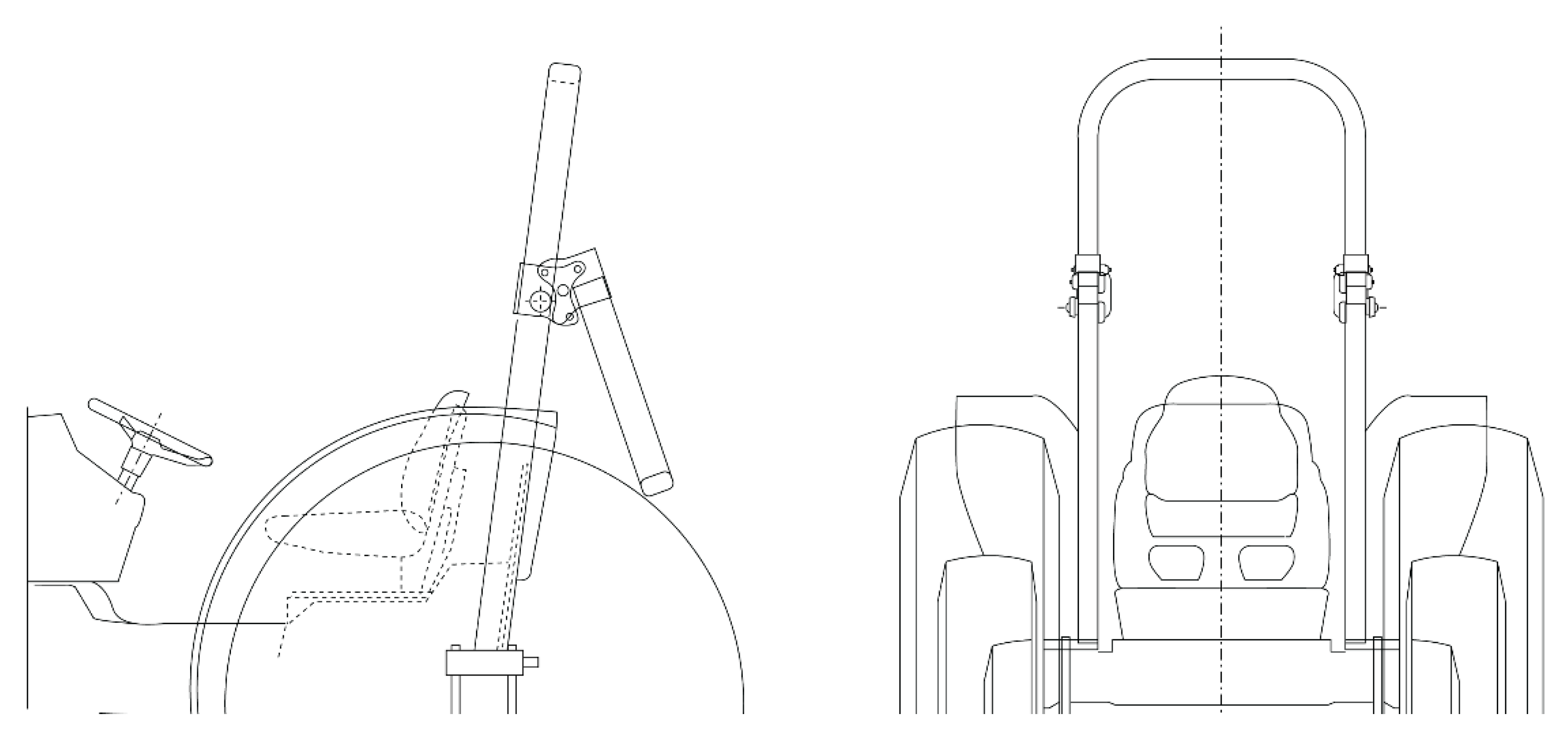
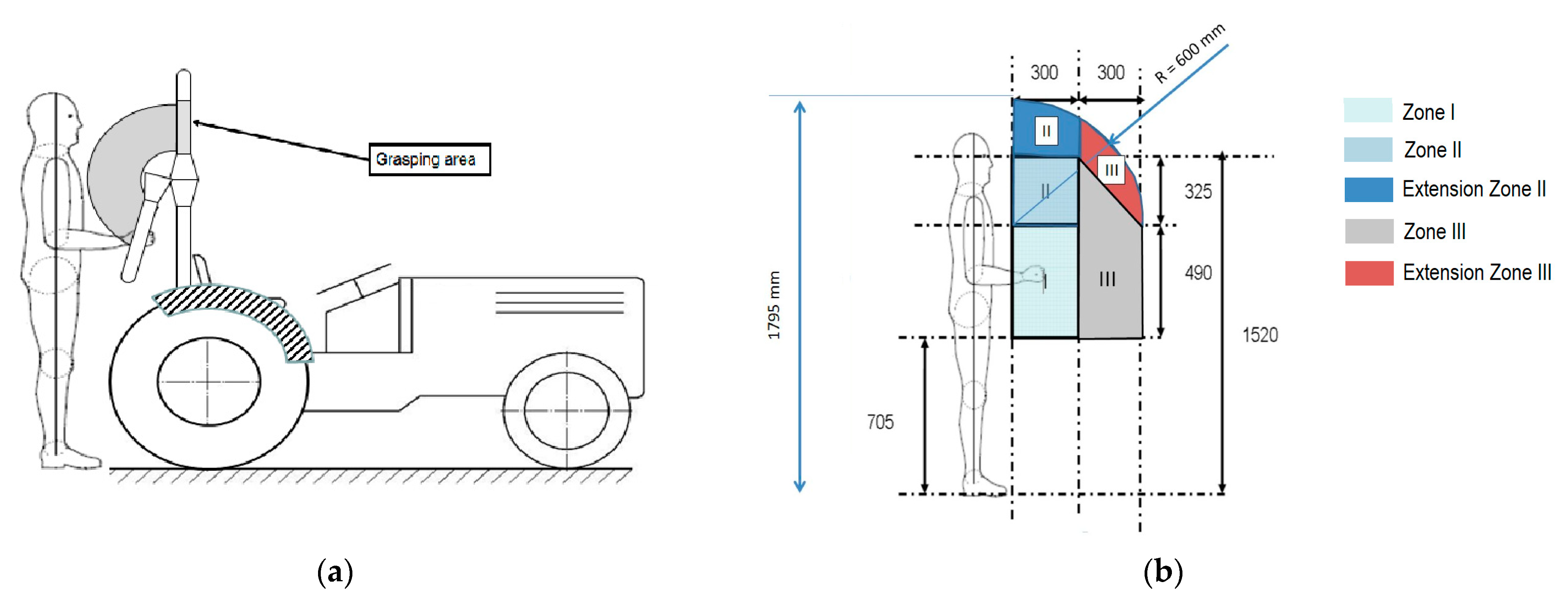

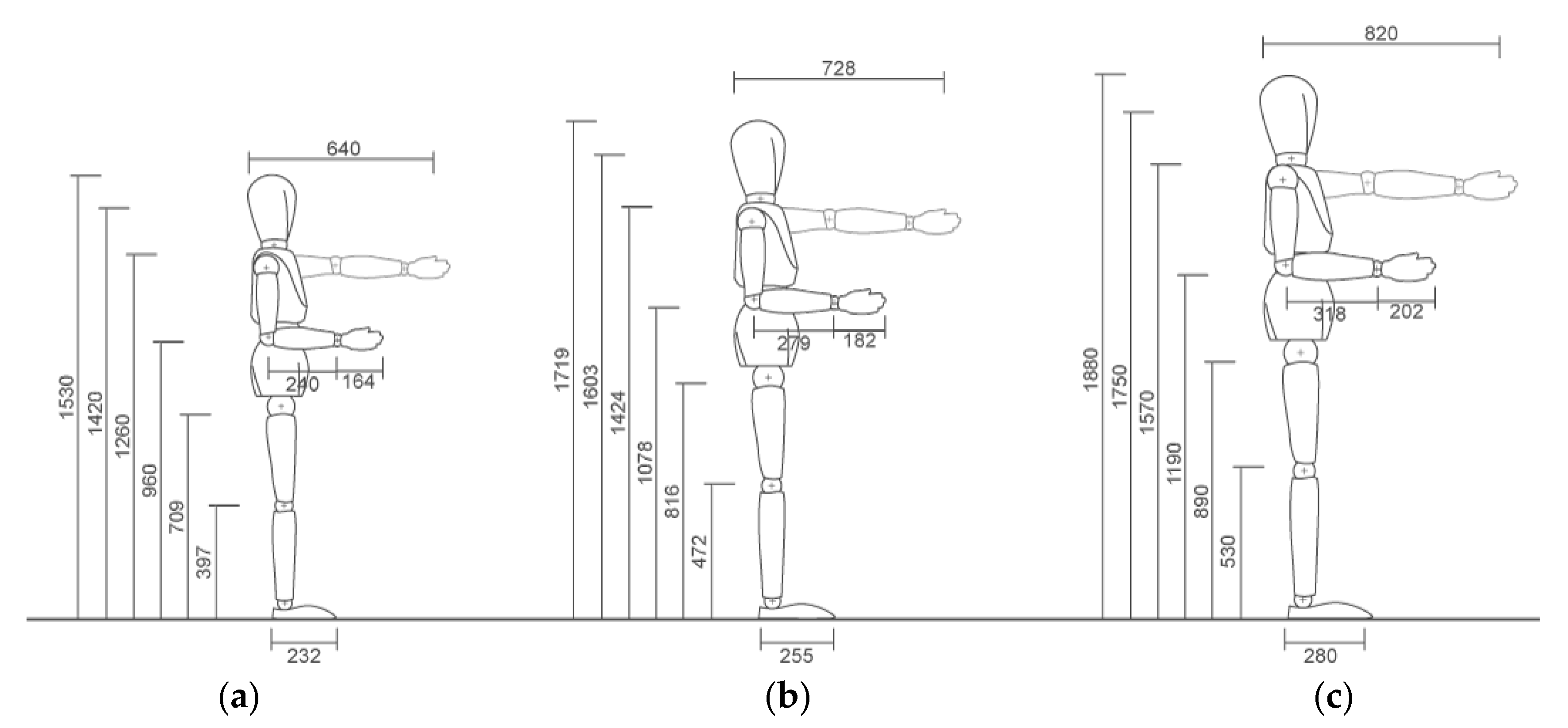
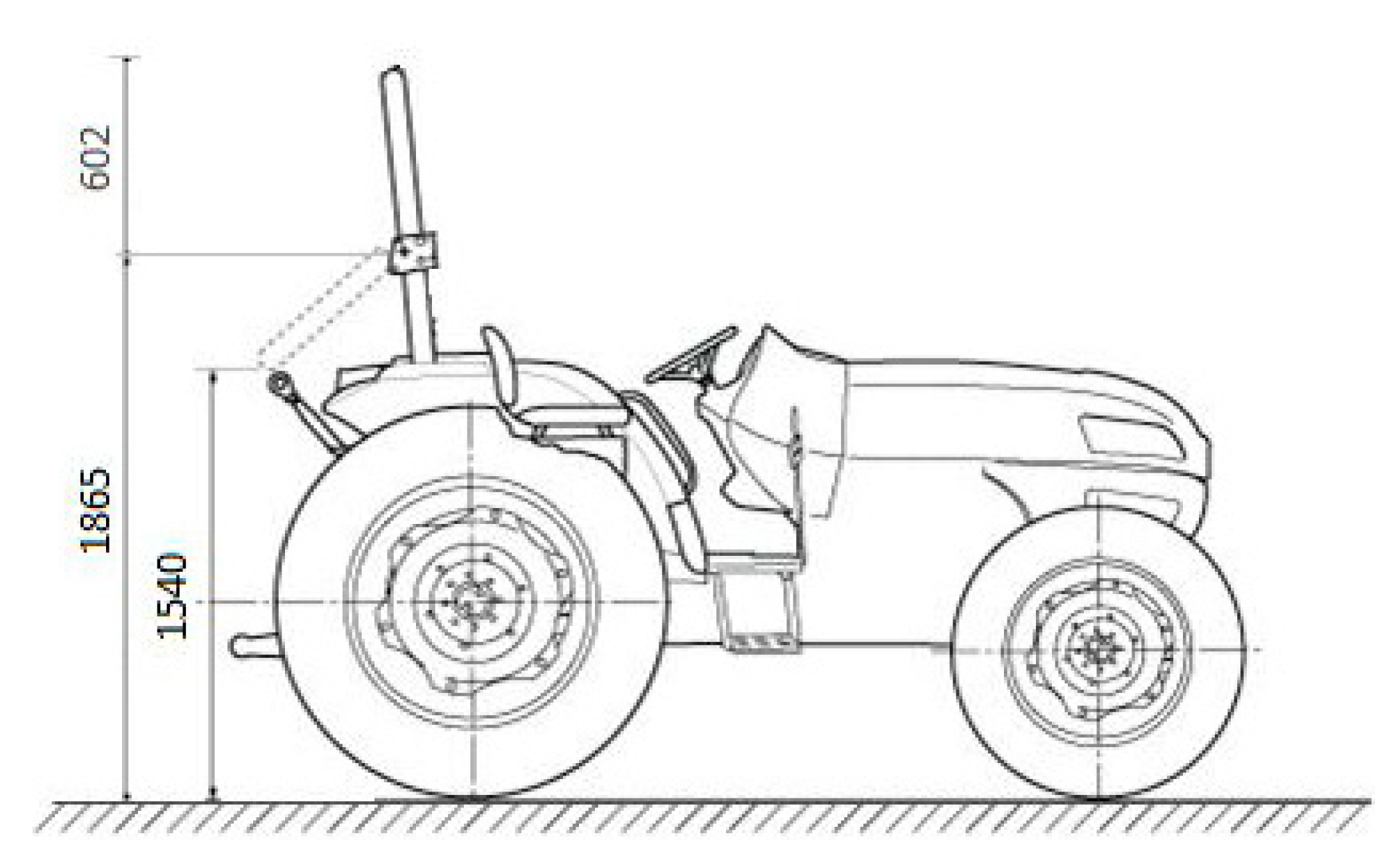

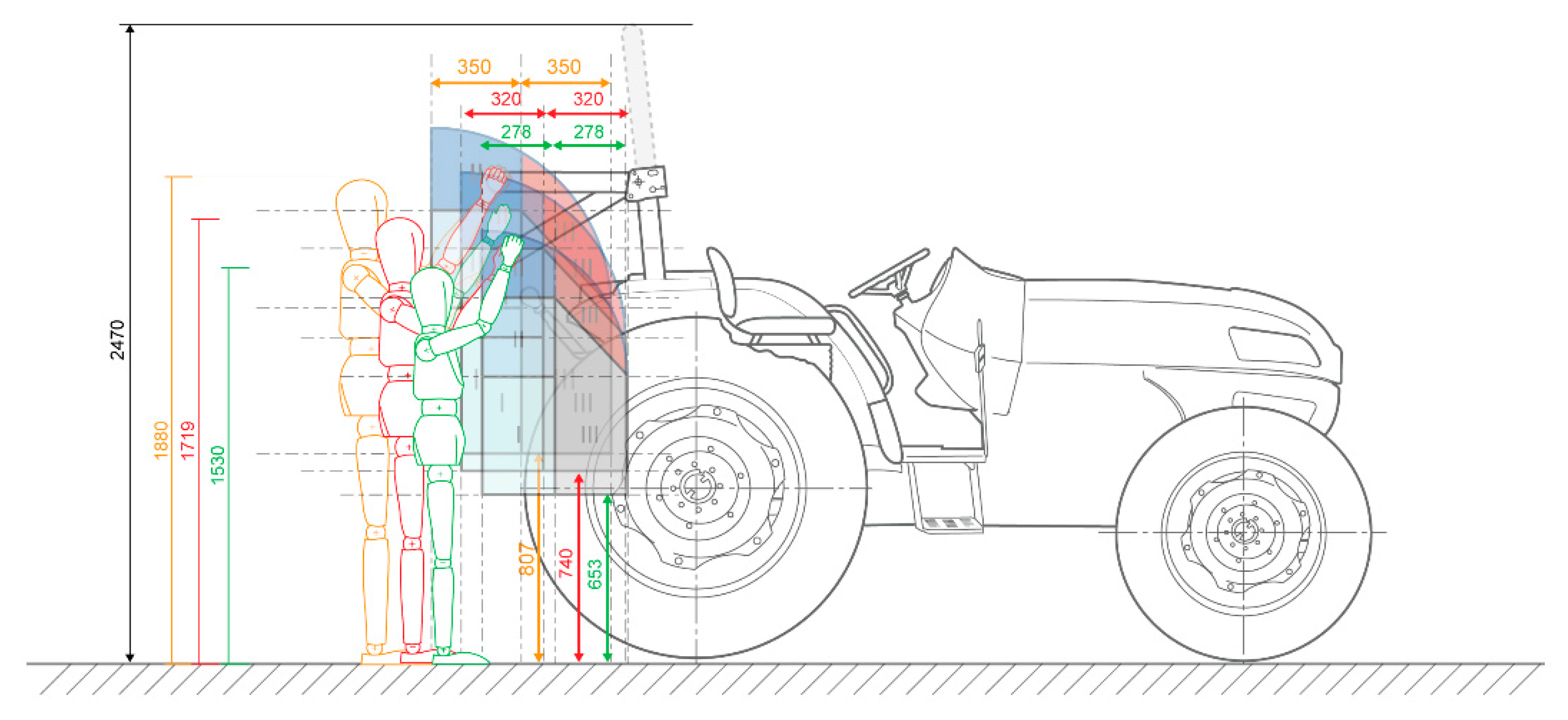

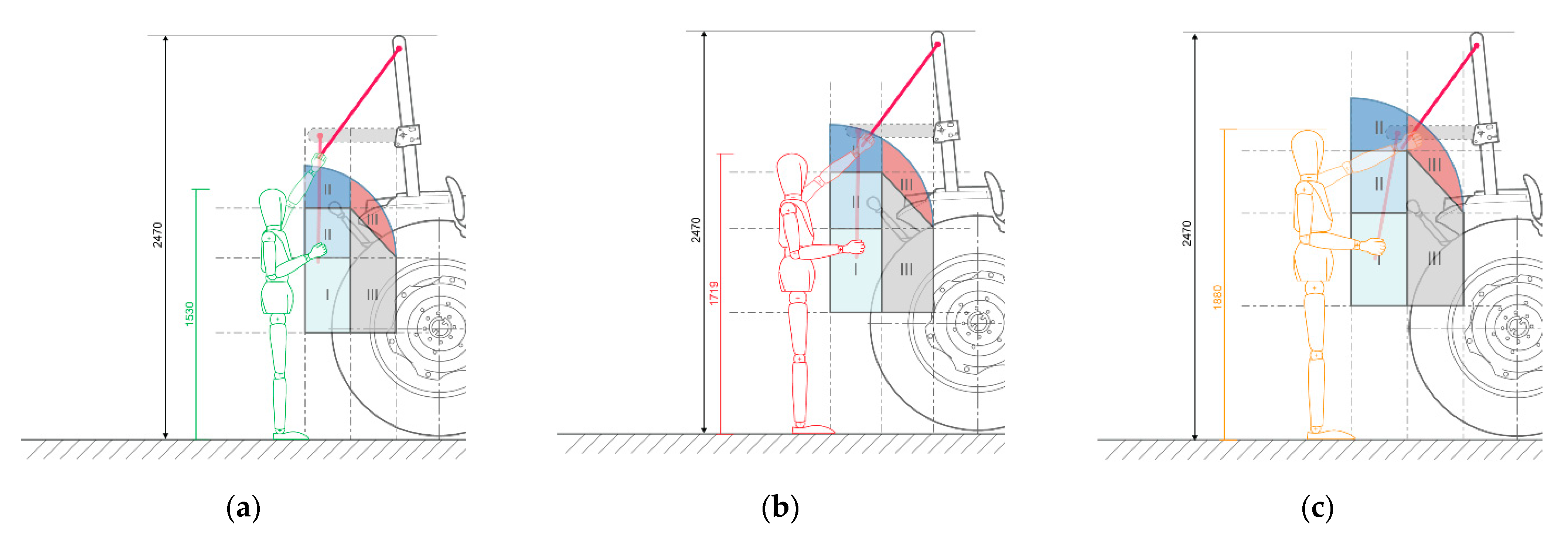
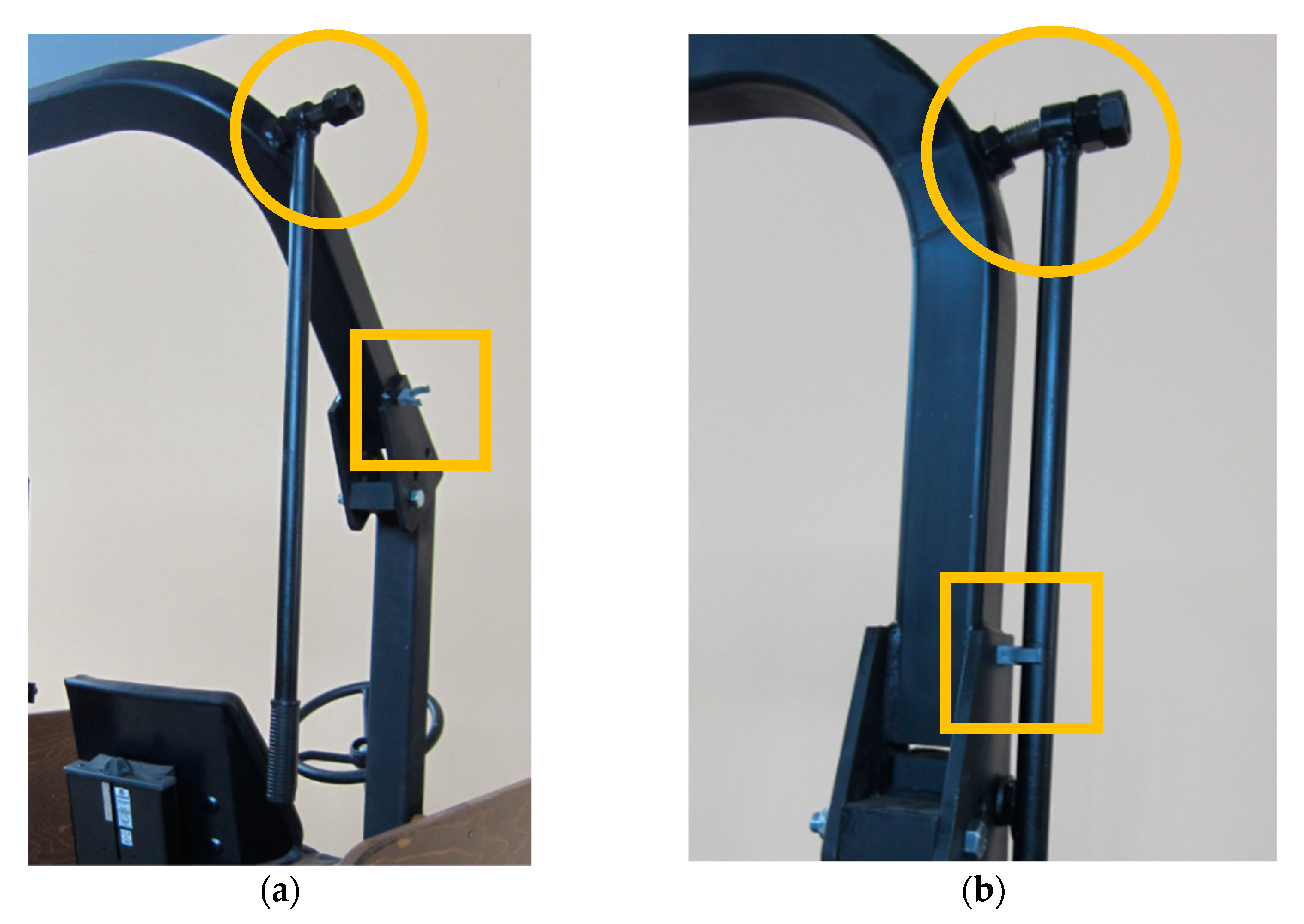
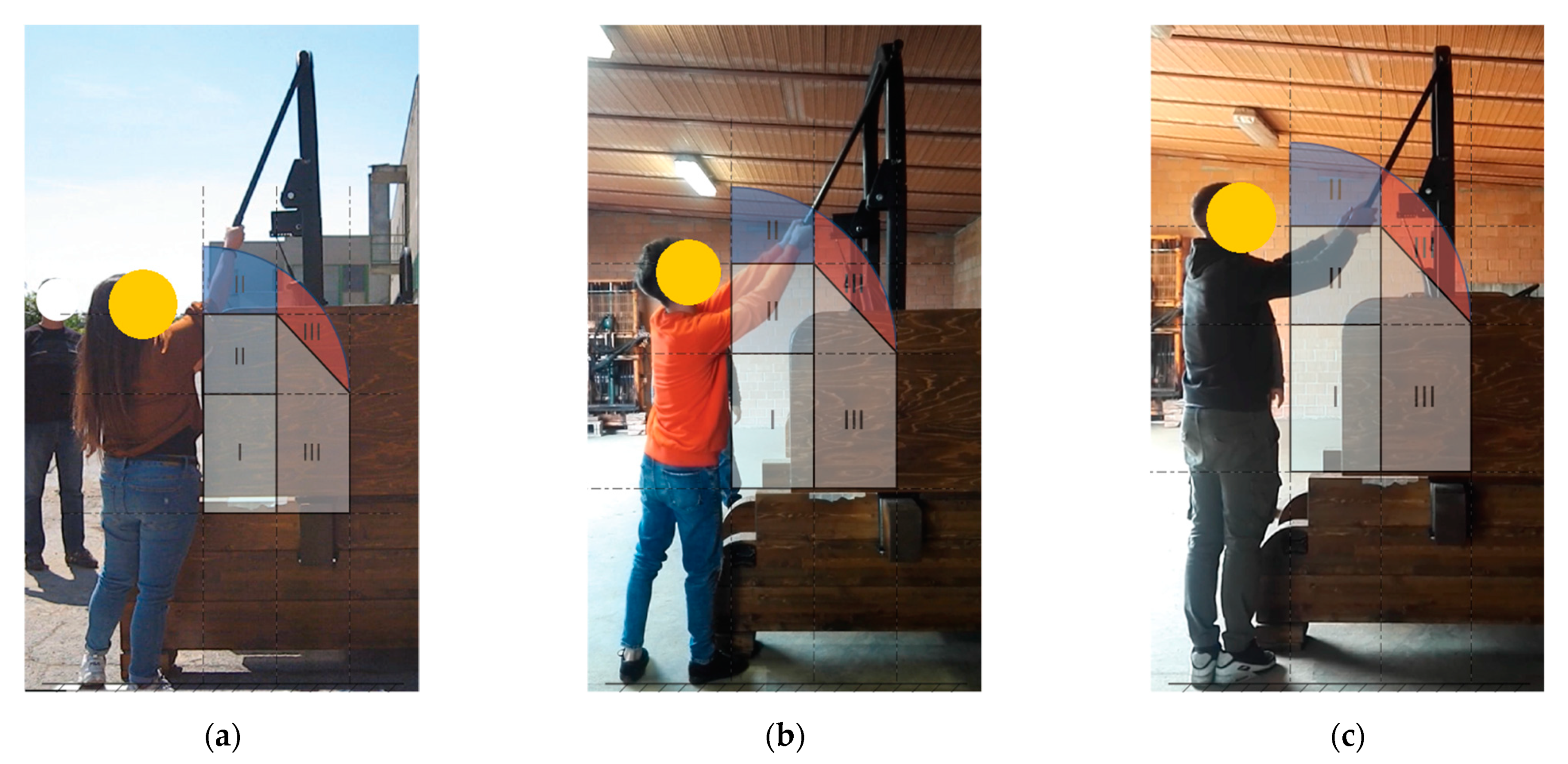
| Swivelling Manually Operated Parts at 45° | Swivelling Manually Operated Parts at 90° | |||
|---|---|---|---|---|
| Height from the Ground | Lowering | Lifting | Lowering | Lifting |
| 1920 | - | - | 500 N | 500 N |
| 1610 | 300 N | 500 N | - | - |
| 1380 | 300 N | 400 N | - | - |
| 1220 | - | - | 500 N | 300 N |
| 790 | 500 N | 500 N | - | - |
| Distance Ground-Gripping Point FROPS at 45° (Folded-Down Position) | Distance Ground-Gripping Point FROPS at 90° | |||
|---|---|---|---|---|
| Percentile | 1540 mm (from Observation) | 1610 mm (KAN Study 50) | 1865 mm (from Observation) | 1920–2150 mm (KAN Study 50) |
| 5th | Extension Zone II | Extension Zone II | / | / |
| 50th | Zone II | Limit Extension Zone II and Zone II | Limit Extension Zone II | / |
| 95th | Zone II | Zone II | Extension Zone II | Extension Zone II |
Publisher’s Note: MDPI stays neutral with regard to jurisdictional claims in published maps and institutional affiliations. |
© 2021 by the authors. Licensee MDPI, Basel, Switzerland. This article is an open access article distributed under the terms and conditions of the Creative Commons Attribution (CC BY) license (https://creativecommons.org/licenses/by/4.0/).
Share and Cite
Micheletti Cremasco, M.; Vigoroso, L.; Caffaro, F.; Paletto, G.; Cavallo, E. Considering Human Variability in the Design of Safe Interaction with Agricultural Machinery: The Case of Foldable Roll-Over Protective Structure (FROPS) Manual Handling. Agronomy 2021, 11, 1303. https://doi.org/10.3390/agronomy11071303
Micheletti Cremasco M, Vigoroso L, Caffaro F, Paletto G, Cavallo E. Considering Human Variability in the Design of Safe Interaction with Agricultural Machinery: The Case of Foldable Roll-Over Protective Structure (FROPS) Manual Handling. Agronomy. 2021; 11(7):1303. https://doi.org/10.3390/agronomy11071303
Chicago/Turabian StyleMicheletti Cremasco, Margherita, Lucia Vigoroso, Federica Caffaro, Giuseppe Paletto, and Eugenio Cavallo. 2021. "Considering Human Variability in the Design of Safe Interaction with Agricultural Machinery: The Case of Foldable Roll-Over Protective Structure (FROPS) Manual Handling" Agronomy 11, no. 7: 1303. https://doi.org/10.3390/agronomy11071303






